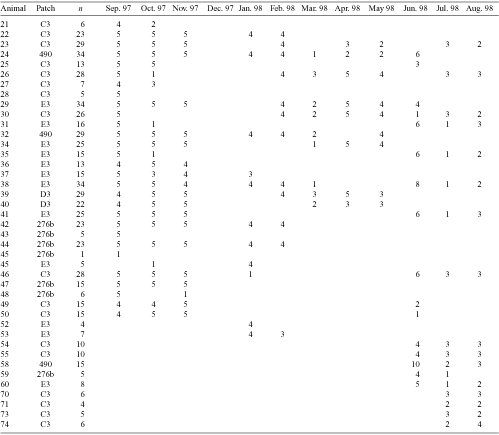Patch use by the greater glider (Petauroides volans) in a fragmented forest ecosystem. III. Night-time use of trees
R. B. Cunningham A , M. L. Pope A B and D. B. Lindenmayer AA Centre for Resource and Environmental Studies, The Australian National University, Canberra, ACT 0200, Australia.
B Current address: State Forests of New South Wales, Tumut, NSW 2720, Australia.
Wildlife Research 31(6) 579-585 https://doi.org/10.1071/WR02112
Submitted: 29 November 2002 Accepted: 13 February 2004 Published: 23 December 2004
Abstract
Night-time use of feed trees by 40 radio-collared individuals of the greater glider (Petauroides volans) was recorded within five remnant patches of eucalypt forest near Tumut in south-eastern Australia. Radio-collared animals were observed making 663 night-time visits to 433 trees. For these observations, we recorded the number of visits by an animal to each tree, the number of different animals using each tree, the characteristics of trees that animals used, and the category of activity or behaviour displayed by animals (classified as feeding, perching, and moving).
We found no evidence of a significant difference in patterns of behaviour between male and female P. volans in their night-time use of trees within remnant patches, regardless of patch size or population density. There were few records of animals (4%) from the radiata pine (Pinus radiata) plantation that surrounded the eucalypt remnants, although 20 observations were made of P. volans feeding on the young male cones and buds of this introduced tree species. There was evidence of preference for feeding in ribbon gum (Eucalyptus viminalis), mountain gum (E. dalrympleana) and narrow-leaved peppermint (E. radiata), with 72% of feeding observations of P. volans coming from these three tree species. Animals were generally solitary and spent most of the night feeding and perching in the upper canopy. Most trees were used by a single individual, with 96% of observations being of a single animal in a tree. The limited number of cases of sharing and co-use of trees were generally between an adult male and adult female (assumed mates), and females and their young. The probability that a tree was used increased with the average size of a tree (a composite measure of diameter, height and crown features) until approaching an asymptote of 1.0, i.e. all large trees were used. The number of visits a tree received from P. volans also was positively related to the measure of its size.
Bennett, A. F. , Lumsden, L. F. , Alexander, S. A. , Duncan, P. E. , Johnson, P. G. , Robertson, P. , and Silveira, C. E. (1991). Habitat use by arboreal mammals along an environmental gradient in north-eastern Victoria. Wildlife Research 18, 125–146.
Braithwaite, L. W. , Dudzinski, M. L. , and Turner, J. (1983). Studies on the arboreal marsupial fauna of eucalypt forests being harvested for woodpulp at Eden, N.S.W. II. Relationship between the fauna density, richness and diversity, and measured variables of the habitat. Australian Wildlife Research 10, 231–247.
Comport, S. S. , Ward, S. J. , and Foley, W. J. (1996). Home ranges, time budgets and food-tree use in a high-density tropical population of greater gliders, Petauroides volans minor (Pseudocheirdae: Marsupialia). Wildlife Research 23, 401–419.
Foley, W. J. , Lassak, E. V. , and Brophy, J. (1987). Digestion and absorption of Eucalyptus essential oils in greater glider (Petauroides volans) and brushtail possum (Trichosurus vulpecula). Journal of Chemical Ecology 13, 2115–2130.
Kavanagh, R. P. , and Lambert, M. J. (1990). Food selection by the greater glider, Petauroides volans: is foliar nitrogen a determinant of habitat quality? Australian Wildlife Research 17, 285–299.
Lindenmayer, D. B. , Cunningham, R. B. , and Donnelly, C. F. (1993). The conservation of arboreal marsupials in the montane ash forests of the Central Highlands of Victoria, south-east Australia. IV. The distribution and abundance of arboreal marsupials in retained linear strips (wildlife corridors) in timber production forests. Biological Conservation 66, 207–221.
| Crossref | GoogleScholarGoogle Scholar |
Pope, M. L. , Lindenmayer, D. B. , and Cunningham, R. B. (2004). Patch use by the greater glider (Petauroides volans) in a fragmented forest ecosystem. I. Home range size and movements. Wildlife Research 31, 559–568.
Robinson, S. K. (1998). Another threat posed by forest fragmentation: reduced food supply. Auk 115, 1–3.

Tyndale-Biscoe, C. H. , and Smith, R. F. C. (1969). Studies on the marsupial glider Schoinobates volans (Kerr). II. Population structure and regulatory mechanisms. Animal Ecology 38, 637–649.

White, N. A. (1999). Ecology of the koala (Phascolarctos cinereus) in rural south-east Queensland Australian Wildlife Research 26, 731–744.

Zanette, L. , Doyle, P. , and Trémont, S. M. (2000). Food shortage in small fragments: evidence from an area-sensitive passerine. Ecology 81, 1654–1666.


|


